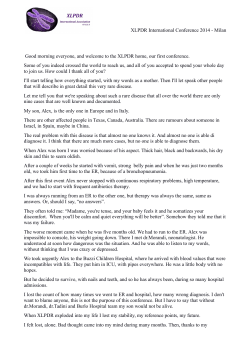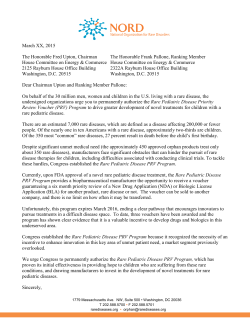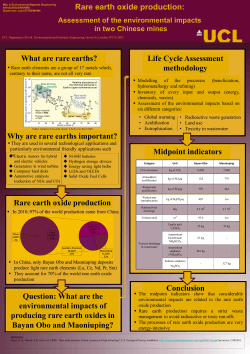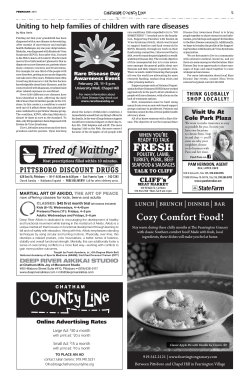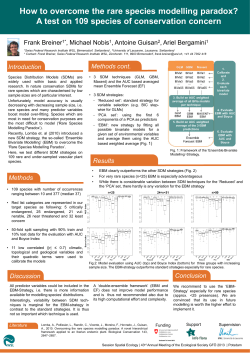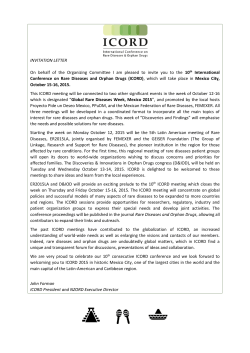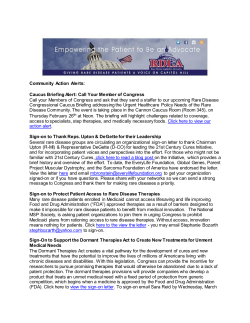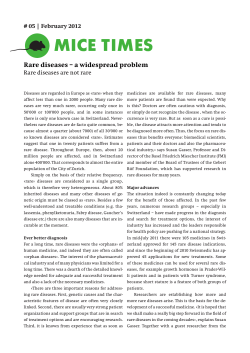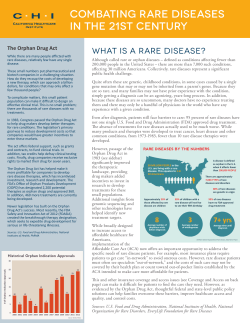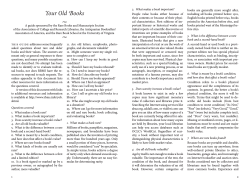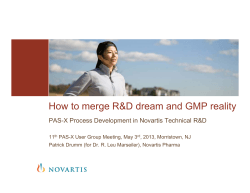
small Is THE NEW BIG
small IS THE NEW BIG Rare diseases: How to get noticed With almost 8,000 rare diseases to choose from, drawing attention to just one requires a multi-pronged effort. Among them are awareness events like Rare Diseases Day, which draws attention to the category. That’s one thing, but Wendy White, founder of niche pharmaceutical marketing firm Siren Interactive, notes, “The challenge is getting through the clutter.” In addition to the key role played by advocacy groups, having a celebrity link is a natural way to make a connection between a rare disease and its impact. Huntington’s disease has become recognized because singer/ songwriter Woody Guthrie died of the degenerative disorder, White says. Parents have also been quite active. John Crowley went so far as to fund a biotech company in hopes of finding a treatment for his children who suffer from Pompe’s disease. Matt and Lori Sames (shown above with their three daughters) are empowered rare disease caregivers and advocates. Their youngest, Hannah, was diagnosed with giant axonal neuropathy, a rare genetic disorder, in 2008. They are currently on track with the FDA to begin a human clinical trial later this year. 44 MM&M x APRIL 2012 x mmm-online.com A target of 300 endocrinologists seems pretty specific. And small. After all, health headlines often focus on broad issues, like the 78 million obese adults or the 26 million Americans with diabetes. Yet 300 is the number of specialists tiny Corcept Therapeutics is aiming for as it gears up to launch its recently approved, firstto-market Cushing’s Syndrome drug Korlym (mifepristone). The FDA estimates Korlym could help about a quarter (or 5,000) of the condition’s 20,000 US patients. Korlym has a previous life as part of the abortion pill compound RU-486—and a contraindication in pregnant women, of course. Corcept’s VP, commercial operations, Steven Lo finds an added bonus in drawing such a small customer base: “I don’t have to hire an army of sales reps,” he tells MM&M. Unsurprisingly, Big Pharma is used to thinking big. But Corcept and a host of other companies are beginning to focus on health stories that grab less boldfaced treatment. They are turning to the rare-diseases category and to conditions that affect patient groups with populations smaller than some small towns. Inducements to find and develop drugs for so few people include incentives that go beyond the seven years of patent status under the 1983 Orphan Drug Act. These include government grants that can help defray the costs of clinical trials. The awards range from $200,000 to $400,000 per year depending on the trial phase. Recent developments suggest progress, albeit uneven. In 2011, 14 new drugs, new formulations and products with new manufacturers PHOTO COURTESY MATT SAMES Orphan drug approvals are up, thanks to marketing exclusivity and development incentives. Deborah Weinstein charts the industry’s drive to think small, highlighting tactics for drawing attention Orphan drug approvals, 2011 Brand Company Adcetris Seattle Genetics IndicationApproval Hodgkin lymphoma Aug 19 Banzel Eisai Lennox-Gastaut syndrome (new formulation) Mar 3 Erwinaze Eusa Pharma USA Lymphoblastic leukemia Nov 18 Ferriprox ApoPharma Transfusional iron overload due to thalassemia syndromes Oct 14 Firazyr Shire Hereditary angioedema Aug 25 Jakafi Incyte Myelofibrosis Nov 16 Makena Ther-Rx Preterm birth (new manufacturer) Feb 3 Nithiodote Hope Pharmaceuticals Acute cyanide poisoning (new manufacturer) Jan 14 Nulojix Bristol-Myers Squibb Kidney transplant rejection Jun 15 Onfi Lundbeck Lennox-Gastaut syndrome Oct 21 Phoslyra Fresenius Medical Care North America End-stage renal disease (new formulation) Apr 19 Xalkori Pfizer Metastatic non-small cell lung cancer (NSCLC) that is anaplastic lymphoma kinase (ALK)-positive Aug 26 Yervoy Bristol-Myers Squibb Unresectable or metastatic melanoma Mar 26 Zelboraf Roche Unresectable or metastatic melanoma with the BRAFV600E mutation Nov 17 were approved that had garnered FDA orphan drug status (including 10 new NMEs and BLAs), a head-over-heels improvement from 2010’s total of zero, and a 367% improvement over 2009, when just three such drugs were sanctioned, according to stats tabulated by Monthly Prescribing Reference. Maximizing resources Lo says Corcept can maximize its marketing resources by targeting the 300 endocrinologists who handle 70% of US Cushing’s cases, which is a significant benefit for a company of twenty full-time staff employees and two full time commercial employees. The sales push will consist of professional outreach by medical science liaisons, professional advertising by Natrel Communications, CME, and patient and digital advertising by Compass Healthcare Marketers, an agency focused on orphan and specialty drugs. The hormone-blocking drug is scheduled to hit the market in May. Lo says Corcept has a good relationship with payors. Although, based on past experience, there’s reason to be skeptical until Corcept releases its Korlym price (it was not available at press time). He notes that patients have little choice, particularly ones for whom surgery has failed to tamp down the condition’s out-of-control cortisol levels. “It’s not one of these ‘I’ll replace this with another drug,’ because there’s not another drug they can use.” Rare diseases offer a massive opportunity, in theory. Experts estimate that the number of diseases affecting populations of 200,000 patients or fewer falls between 6,000 and 8,000 conditions. Europe has a different threshold for a rare disease treatment population. Despite the small patient numbers, research by the UK firm GlobalData indicates that there is growing financial support for tackling these diseases. Its latest Cushing’s Syndrome dossier, for instance, estimates the condition’s therapeutics market will be worth about $90.8 million in seven years. Garnering attention to rare diseases involves several other tactics. One is the indisputable role played by families. Mother Pat Furlong is a reference point for the rare disease community. She founded the Parent Project Muscular Dystrophy 10 years after her sons were diagnosed with the most fatal form of muscular dystrophy, called Duchenne’s (see sidebar for other examples of family advocates). “There is no force in nature stronger than a mother with a sick child. She’ll do anything and go to great lengths and bridge any chasm to figure out how to get things moving,” says Dr. Tim Cote, the former head of the FDA’s Orphan Products Development program. That’s not to say that a single voice is the only way to push the pipeline. Like Furlong’s organization, the Leukemia & Lymphoma Society is another example of an organization putting money toward finding a cure. LLS provides academic grants and partners with biotechnology and pharmaceutical companies. LLS manages to fund about 90% of its grant applications and has a success rate that hovers between 10% and 12%, says the society’s EVP, Dr. Louis DeGennaro. For Novartis, patient advocacy groups have had a clear impact. By associating with the organizations, they have helped Novartis “understand the perspective and unmet needs of people living with rare diseases,” the drugmaker notes in an e-mail. As an example: the Spinal Muscular Atrophy Foundation “had a pivotal role in SMA research and development efforts, helping develop alliances among healthcare companies, such as Novartis, academic researchers and patient groups.” Scattered success But progress in rare diseases is modest. Dr. Cote, who is now chief medical officer of NORD (the National Organization for Rare Diseases), tells MM&M that only 400 orphan drugs have come to market since 1983, and those treat only about 200 diseases. Cote says that drug repurposing, mmm-online.com x APRIL 2012 x MM&M 45 small is the new big like that of Korlym, has had scattered success at best, although it’s a tack the National Institutes of Health is invested in through a program that essentially scans current approved medications and looks for rare-disease applications. Cote says repurposing drugs has an additional drawback: retroactively applying an already approved drug may be great for patients, but companies cannot charge more money for the same medication. This somewhat tempers the benefit of seven years of exclusivity. Korlym skirts this problem because the stand-alone mifepristone is different from RU-486, of which mifepristone is a component. Instead, Cote says the future of orphan drugs and the incentives lie in creating—from scratch—treatments that specifically target rare diseases. Dr. Yann Echelard of GTC Biotherapeutics agrees. The VP of corporate and technology development says that pharma used to consider rare diseases a costly category that would tax pharma coffers with little hope of a return, but the economics are rapidly changing. Five years ago, GTC received orphan drug status for ATryn, its drug for treating hereditary antithrombin deficiency, a condition affecting about one in 5,000 people in the US. While it’s expensive to create biologics like ATryn, rare disease treatments can have lower development costs, particularly when it comes to clinical trials. In short, a smaller population means a smaller test group, bringing down cost. Echelard adds that although biologics work on a granular level, these treatments still have spin-off potential. Case in point: GTC 46 MM&M x APRIL 2012 x mmm-online.com is looking at a drug that may have more than one use but the first approval is still in the wings and a secondary one would probably lag by two or three years. Bigger players Small firms like GTC and Corcept are not the only ones who see potential in rare diseases. Major players including Novartis and GlaxoSmithKline are also finding their way into the market. In addition to launching its rare diseases unit two years ago, GSK signed a $300 million deal with the Canadian biotech Angiochem in March to investigate treatments for lysosomal storage diseases, an umbrella category that includes Fabry Disease, Gaucher’s Disease and Hunter’s syndrome. Fabry affects approximately one in every 40,000 to 60,000 men and is less frequent in women. “The risk associated with product discovery and development in rare diseases is generally lower than other disease areas as disease definitions are very clear and clinical trials tend to be small with robust endpoints,” GSK’s Patrick Vallance, SVP of drug discovery, said in statement when the unit launched. Novartis, also in the game with its Institutes for BioMedical Research, is working on more than 40 rare diseases, notes a company representative by e-mail. The company dedicated 20% of last year’s pharmaceutical sales to R&D for rare and neglected diseases. Novartis also hosted the first global Rare Disease R&D c onf erence, held in February at its headquarters in Basel, Switzerland. n
© Copyright 2025
